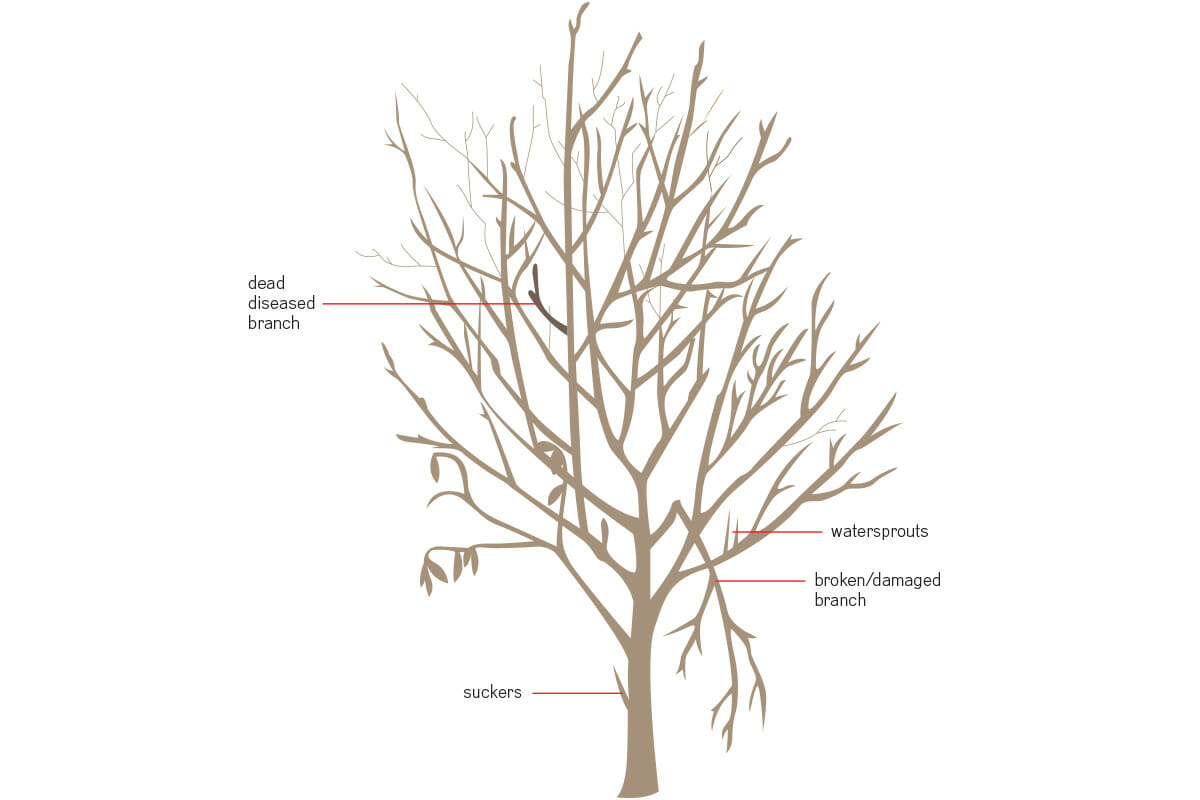There are several different types of tree pruning, including basic, structural, crown lifting, and crown thinning. All of them are vital to the health and beauty of a tree, but some types are better suited to certain purposes. If you have a tree that blooms in spring, it’s best to prune it when the flowers have faded so it will grow vigorously in the spring. If you wish to prune it during the winter to slow the growth of unwanted branches, do it after the coldest part of winter.

Basic of Tree Pruning
In basic tree pruning, cutting branches of a tree is done with a sharp knife, beginning with an upward cut an inch or two below the collar of the branch. Keeping in mind the direction of the tree’s growth, the cut is completed by cutting the branch back to the collar. In young trees, cutting away one of the trunks is necessary to prevent it from splitting, which weakens the overall strength of the tree. A sharp knife is recommended for this task.
It is essential to avoid a tree’s health if the procedure is performed incorrectly. A poorly pruned tree may be weakened and can develop branches that are potentially dangerous to people. When properly performed, a tree’s trunk remains sturdy, making it less vulnerable to diseases. Pruning should never occur in the fall because rains in our area can promote fungal growth. Furthermore, diseases can spread more readily at this time of the year.
Using a saw, an experienced arborist can make a more accurate cut. Depending on the tree’s age, a novice may want to cut the branch off at its base to avoid damaging the roots. Pruning is a vital process that helps trees grow strong and beautiful. Moreover, it can help to improve the structure and health of the tree. Listed below are some tips on how to perform basic tree pruning.
Branches should be cut at least one-third of the stem diameter. In addition, the branch ridge is located on the upper surface of the stem. Cut off branches that are outside of the ridge. Make sure the cuts are as close to the stem as possible. Then, make a second cut, this time outside of the first one. The final cut should be at least half the stem diameter. If you can’t find a branch collar on a branch, you should use the same technique as if it were a live branch.
Advanced Tree Pruning
In this type, hygienic and cosmetic methods of pruning are used, to enhance the natural shape of your trees. While you can prune away dead, diseased, and broken wood at any time of the year, general pruning should be done in the early spring, just as the plant begins to grow. Listed below are some of the techniques. You may be surprised to learn which techniques are best for your particular situation!
A pole saw is a long pole with a sharp blade on one end. You must be an advanced tree pruner to use a pole saw. It is essential to follow borough-specific rules when using it. Also, make sure you stay at least 10 feet away from overhead electrical wires while pruning. Advanced tree pruning also includes trimming individual branches to promote new growth. However, this is best left to professionals who have extensive training in this discipline.
Crown Reduction
Crown reduction is a technique that aims to reduce the overall height of trees by removing small branches attached to heavier branches. This is important for young trees, which can easily become top-heavy. Properly pruned trees have a rounded crown, which encourages big growth. However, in some cases, the branch collar is damaged. In such cases, the pruning process may involve several visits. And, as with any pruning technique, a tree will need several visits for proper pruning to be effective.
Another advanced tree pruning technique is tree lacing. These techniques are performed by a trained professional and can leave your trees looking incredibly elegant. Though most homeowners have never heard of this technique, it is something you must hire a professional for. By applying lacing techniques, the figure and outline of your tree will look more elegant.
Structural
Tree pruning is a type of trimming that involves finding and removing the primary structure of the tree. It should be evenly spaced with no clusters of branches. This pruning style is best for mature trees and should be done periodically for improved health and stability. It is usually done every few years on mature trees. It should not be performed on young trees. Read on to learn more about the benefits of structural pruning. Here are some common mistakes to avoid.
Older trees are not subject to the same kind of structural changes as young trees, and parts of the tree will not be as large. Nevertheless, structural pruning is still recommended for codominant stems and limbs. The focus of structural pruning is to minimize the length of the stem and remove defects. Leaving secondary branches behind the reduction cut can reduce the growth rate of the stem that was pruned. Secondary lateral branches also contribute to structural problems, since they do not relieve the mechanical stress experienced by the trunk.
A good rule of thumb is to encourage a single dominant leader in a tree. When this does not happen, pruning should focus on reducing the length of competing leaders and removing weaker ones. Generally, reduction cuts of two to three inches in diameter are sufficient. Larger cuts may lead to significant decay in the stem, and they may even split the tree. But, in some instances, the tree may need further structural pruning before it has a chance to recover.
Proper pruning is an essential part of landscape tree maintenance. Proper pruning techniques help preserve a tree’s health and look.
Crown lifting
Crown lifting involves removing lower branches from a tree in order to make it look better. Sideshoots produce sugars that help the main trunk grow thicker. Crown lifting can also weaken a tree’s trunk if you prune too much. Standard specimen trees are trained and trimmed before being purchased, so crown lifting is a common procedure for these trees. Crown lifting can also be done to feathered maiden trees, which have side shoots that develop after a few years of growth.
There are many benefits to crown lifting during tree pruning. One of the main benefits of removing lower branches is to give the crown more room. Additionally, crown lifting prevents trees from getting too dense, which can break in a storm or if a person walks under them. Crown lifting also reduces strain on the lower limbs. Winter pruning should be done sparingly. Crown lifting is a safer alternative to pruning an entire tree and will help remove energy-producing buds.
The process of crown lifting is simple and easy if you know how to use the right tools. You should wear gloves when performing crown lifting, and you should carefully assess the tree before beginning the procedure. Once you know what parts of the tree need lifting, cut the lowest branches with a clean, slightly angled cut. Leave about 5 mm of space between the cut and the trunk of the tree. Make sure to do this every two years, as it will help prevent silver leaf disease during the winter months.
Using the crown lifting technique allows more light to penetrate beneath the branches. It reduces the amount of shade cast on the tree’s canopy and also exposes views below the trees. It should be done sparingly to prevent unnecessary damage to the tree. If you’re considering crown lifting for a tree in your yard, make sure you consult a professional tree lopper expert before getting started. If you’re unsure about how to perform the procedure, check with the local government or a professional tree surgeon.
Topping
Topping a tree is a common practice in many areas. It removes fifty to one hundred percent of a tree’s crown, including leaves. Since trees live on leaves, this removal places strain on their ability to produce energy and release water. Elm trees, for example, need 250 to 300 gallons of water per day to support themselves. Additionally, topping a tree can cause the rapid growth of multiple shoots below the cut.
Topping is not recommended for every situation. It can weaken a tree and result in unsightly stubs. The lopped-off branches may also create a hazard for people and wildlife. Topping is not recommended by any legitimate landscape professional and is a potentially dangerous practice.
Topping trees is a dangerous practice because it exposes the remaining limbs to excessive sunlight. Large stubs left by topping are difficult to heal and are vulnerable to disease and insect infestation. In addition, these limbs are exposed to decay, making them more vulnerable to insect and water damage. This process reduces a tree’s overall value, increases liability, and requires costly future pruning and replacement. Therefore, it is best to hire a professional tree lopping company to perform this type of tree pruning.
Topping is an unsafe practice that can cause serious damage to your tree. Topping is an irreversible mistake that will negatively impact the health and growth of your tree. If you’re considering topping, make sure you ask a professional for assistance if you’re unsure. If you’re not sure about the safety of your tree, consider hiring a tree service. These professionals are more qualified and experienced than you are. If you’re planning on using a tree topping service, make sure it’s done correctly.

